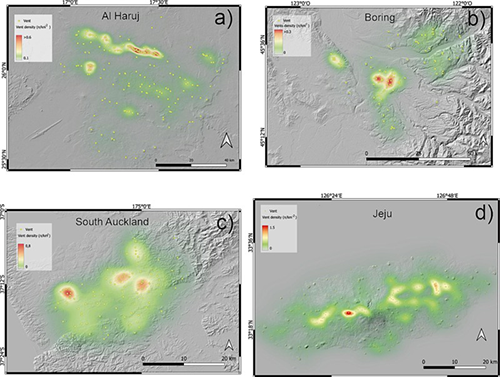Self-similar spatial clustering of volcanic vents: Insights into magma storage depth from global volcanic fields

Francesco Mazzarini, Nicolas Le Corvec, Ilaria Isola (2025).
Journal of Volcanology and Geothermal Research, 467. https://doi.org/10.1016/j.jvolgeores.2025.108431
Abstract
The spatial distribution of volcanic vents in volcanic fields provides critical insights into the structure of underlying magma plumbing systems and the influence of crustal structures and state of stress on magma ascent. This study investigates self-similar clustering of vents in 46 volcanic fields from diverse geotectonic settings to assess whether vent distribution consistently follows fractal patterns, regardless of parametric statistical classifications. Spatial analyses using Nearest Neighbour Distance, Vent-to-Vent Distance and Kernel Density Estimation confirm that the vent self-similar clustering is a fundamental characteristic of distributed volcanism.
The analysis reveals that self-similar clustering is present in all volcanic fields, even in cases where parametric methods suggest a random or over-dispersed distribution. The vent self-similar clustering is defined within a length range bounded by two thresholds, the lower (Lco) and the upper (Uco) cut-offs. They correspond to the shallow depth (< 5 km) at which magma may accumulate without leading to eruption and the depth of the magma reservoir or dike propagation zone, respectively. A strong positive correlation between Uco and magma reservoir depth (H) suggests that vent clustering reflects subsurface magma transport dynamics. Statistical tests confirm that γ₁ and γ₂ parameters, previously defined for volcanic fields in the Main Ethiopian Rift, are effective indicators of vent clustering, with γ₁ consistently ≤0.1 for clustered fields.
These findings underscore the role of fracture networks as efficient pathways for magma ascent, supporting the hypothesis that magma effusion sites are intrinsically linked to crustal mechanical properties. Future research should explore how fracture network evolution influences vent distribution over time and whether the vent self-similar clustering analysis can improve constraints on magma reservoir dynamics and eruption forecasting. Furthermore, applying this framework to extraterrestrial volcanic fields (e.g., Mars) could provide new insights into universal processes governing vent clustering in different planetary environments.



Devi effettuare l'accesso per postare un commento.